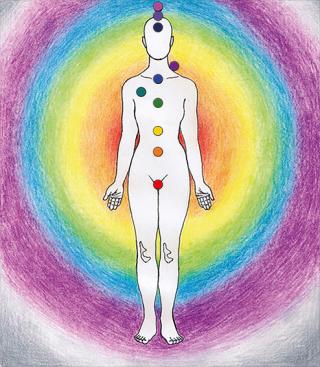-
Aura, chakras and colors
The colors of your chakras are:
- Base chakra = Red
- Navel chakra = Orange
- Solar plexus chakra = Yellow
- Heart chakra = Green
- Throat chakra = Blue
- Forehead chakra = Indigo
- Crown chakra = Purple
- Thymus chakra = Turquoise
- Neck chakra = Magenta (burgundy)
- Star chakra = Pink
Each chakra has a base color, and each color carries its own pattern. Here’s a brief overview:
- Red (Root chakra): Represents power, dominance, direction, purpose, security, and family management. When misplaced in the upper body, it can indicate aggressiveness, anger, irritation, frustration, pain, or fatigue.
- Orange (Navel chakra): Symbolizes creativity, impulses, inventiveness, longing, realization, and passion. In the wrong places (e.g., the upper body), it may signify selfishness, fear, or difficulty concentrating.
- Yellow (Solar Plexus chakra): Reflects the self, ideas, studies, development, and activity in social networks. It involves mental activity. Over large body areas, it can indicate a need for control.
- Green (Heart chakra): Represents love, healing power, tenderness, sensitivity, and community. On the feet or around the head, it can suggest being overly kind or at risk of martyrdom.
- Blue (Throat chakra): Indicates communication, social needs, outgoing energy, presence, and intelligence. On the lower body, it may suggest difficulty listening to oneself and an easy tendency to be controlled.
- Indigo (Third Eye chakra): Shows spiritual philosophy, thinking, sensitivity, and visions. It involves spiritual community and new influences that stimulate new thinking. On the lower body, it may indicate excessive visions or illusions.
- Purple (Crown chakra): Reflects life philosophy, reflections, sensitivity, and a dreamy existence. On the lower body, it suggests floating ambitions and dreams.
- Magenta/Burgundy (Neck chakra): Represents experience, patterns, basic values, and frames of reference.
- Turquoise (Thymus chakra): Indicates changes, reassessments, insights, and spiritual presence.
- Pink (Star chakra): Symbolizes love and infatuation.
- White: Represents spirituality, clarity, miracles, and life flow.
- Gray Fields: Indicate depleted energy and highlight areas of life needing attention.
Your soul has an energy form, often easiest to understand through color. Everything around us is built with colors, each a vibration producing different tones and sounds.
A lesser-known chakra is the thymus chakra, located between the throat and heart, diagonally to the right. It connects you with the soul, spiritual guides, your God, spiritual guidance, spiritual identity, and your true self. The color of the thymus chakra shows your current spiritual development, similar to other chakras. Unlike others, this chakra remains balanced regardless of its color.
The basic color and vibration of chakras change if they become imbalanced due to behavior changes, patterns, negative feelings, or substance use. These can darken the color to gray, brown, or black.
All chakras have positive and negative aspects, representing two energy poles, which can also be seen as masculine (positive) and feminine (negative). Balancing these creates Ki power, the "ultimate" power. This concept parallels the left (logical, masculine) and right (intuitive, feminine) hemispheres of the brain.
You can read chakra energy through colors, known as the aura. For example, anger uses the base chakra's negative force, showing mostly red in the aura. Red also signifies power, strength, intensity, and creativity. Creative joy when positive, but it can become tyrannical.
Together, colors form a prism seen in a rainbow, created by water droplets illuminated by the sun—an analogy to humans, made of about 65% water. Our colors are illuminated by the Sun (life force), and we need to balance both within and around us. White and black, although not true colors, are included in this spectrum.
White represents emptiness, while black is a mixture of all colors, becoming nothing. Black is heavy energy, taking rather than giving. Gray, a perfect mix, symbolizes balance and rest, but can also appear in the aura when unwell or using substances.
Additional energy points include the neck, temples, hands, and feet, known as gray zones that can be colored. Understanding colors enhances your ability to achieve balance and connect cause and effect.
When gray areas appear —indicating voids that lead to illness —it's crucial to address them. Expressions like "seeing red" when angry reflect this connection. Colors have positive and negative qualities, regardless of body location.
Some perceive a "yellow" glow around speakers, linked to the solar plexus chakra (yellow) for the expression of ideas. Others may see a "blue" glow, related to the throat chakra (blue) for communication.
Feeling gray signifies a lack of color, and it can serve as a balance when overwhelmed by one color. Each color is a vibration, and changes in behavior can alter your aura. Carrying gray, black, or white doesn't always indicate imbalance unless persistent. Instead, consider the pattern each color represents and its message.
When you see, paint, or feel the aura, you can discern the whole and its layers. Each color and area has properties that form the self, identity, and soul. Removing a color creates imbalance; all colors are needed for wholeness.
Each chakra has a basic color but can absorb others, leading to imbalance and changes in frequency. If the base chakra, typically red, absorbs blue, it speeds up, becoming fragmented. This may indicate talking rather than acting, requiring a behavior adjustment to restore balance.
Chakra imbalances can lead to illness, reflecting patterns. Address mental limitations to prevent physical issues. When a chakra is imbalanced, work to restore its frequency.

